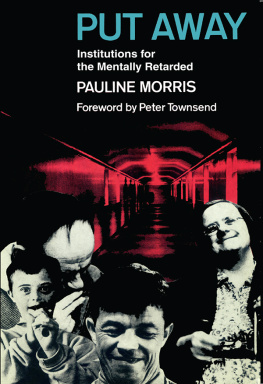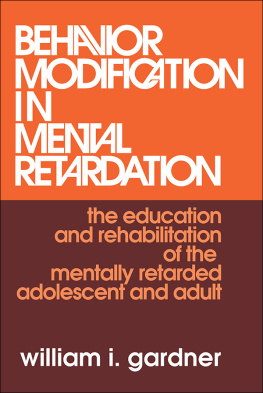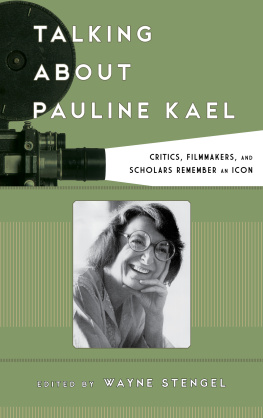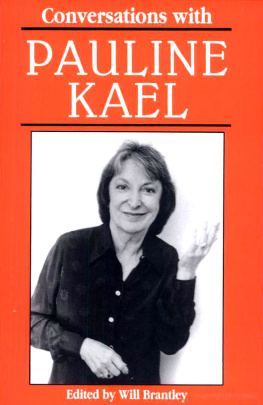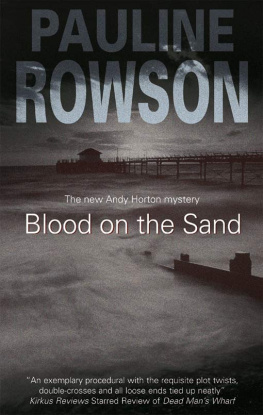PUT AWAY
First published 1969 by Transaction
Publishers Published 2017 by Routledge
2 Park Square, Milton Park, Abingdon, Oxon OX14 4RN
711 Third Avenue, New York, NY 10017, USA
Routledge is an imprint of the Taylor & Francis Group, an informa business
Copyright 1969 by Pauline Morris.
All rights reserved. No part of this book may be reprinted or reproduced or utilised in any form or by any electronic, mechanical, or other means, now known or hereafter invented, including photocopying and recording, or in any information storage or retrieval system, without permission in writing from the publishers.
Notice:
Product or corporate names may be trademarks or registered trademarks, and are used only for identification and explanation without intent to infringe.
Library of Congress Catalog Number: 2006045608
Library of Congress Cataloging-in-Publication Data
Morris, Pauline.
Put away : institutions for the mentally retarded / Pauline Morris ; foreword by Peter Townsend.
p. cm.(Social psychology)
First published in 1969 with a subtitle: a sociological study of institutions
for the mentally retarded.
Includes bibliographical references and index.
ISBN 0-202-30880-4 (pbk : alk. paper)
1. People with mental disabilitiesInstitutional care Great Britain. I. Title. II. Series.
HV3008.G7M6 2006
362.210941dc22
2006045608
ISBN 13: 978-0-202-30880-7 (pbk)
CONTENTS
Historical development Changing concepts and definitions Popular conceptions about subnormality The development of institutional care Estimations of the prevalence of subnormality
Sampling procedures Selection of National Health Service hospitals Selection of residential homes and nursing homes Making contact and visiting institutions Selection of patients Interview schedules Analysis of data Staff attitudes to research Patients attitudes to research - The intensive study Reliability General problems of analysis
Distribution of hospitals Number of beds Patient statistics Social Class Staff Administration Costs
Background characteristics Intelligence Physical disabilities Legal status - Summary
The buildings Inside the hospitals Internal arrangements and conditions Dormitories Day rooms Toilet facilities Linen and clothing Food Summary
Staffing structure Sources of information Medical and ancillary staff Nursing staff Recruitment Staff shortages and conditions of work Training Qualifications of administrative staff Staff views of hospital function Nurses perception of their role Supervising ancillary units Communication between medical and nursing staff Morale Summary
Childrens schools Adults Schools Psychological services Occupational therapy and industrial training Physiotherapy Speech therapy Social work Experimental treatment and training Summary
Admission procedures Life on the ward Patients access to medical superintendent Social control Parole Patients at work Leisure activities Summary
Formal contacts Informal contacts Relatives visits to the hospital Going home Letter writing and the use of telephone Summary
Existing provisions The homes in the sample Finance The physical setting Functions of homes Internal arrangements The patients Schools Occupation Parole Contact with families Parents associations Management committees Staff Contact with Medical Officer of Health Contact with the community Summary
Types of patient and their needs The provision of services Barriers to change Treatment and the nurse The need for flexibility
The model of the total institution The impact of current administrative policy Personality factors in the organizational system The need for change Organizational differences between hospitals and homes Suggestions for organizational change
this study was carried out at the direct invitation of the National Society for Mentally Handicapped Children, whose very real con- cern about residential conditions for the mentally handicapped was expressed through a most generous grant to Professor Peter Townsend, Chairman of the Department of Sociology at the Univer- sity of Essex. I am greatly indebted to the National Society for making the work possible, and to Professor Townsend who entrusted me with the research, yet whose help and supervision was invaluable, particularly in the task of writing the report.
The staff of the Ministry of Health smoothed our path in every way possible and gave helpful advice at all stages of the research. But it is to the staff of all the hospitals and homes visited that we must tender our most grateful thanks; without their willing co- operation no report would have been possible, and I can only hope that the picture which emerges on these pages reflects adequately the wide variety of views expressed by them.
Discussions took place at various stages of the research with workers and practitioners in the field; they are too numerous to mention individually, but I am particularly grateful to Professor Brian Abel-Smith, Professor Alan Clarke, Professor J. Tizard, Dr. A. Kushlick, Mrs. M. Crozier, Dr. P. Mittler, Dr. F. Martin and his research team, and to my husband, for all their help and comments. If inaccuracies remain in the text, or if I have ignored their suggestions, the responsibility is mine alone, for I have not lacked advice.
For most of the duration of the research, Mr. G. Kalton of the London School of Economics, acted as statistical adviser to the project; during his absence abroad his place was taken by Miss Kathleen Gales, and to both I am very much indebted. Also to Mr. P. Wakeford of the London School of Economics computing department who sorted out so many queries so quickly and patiently, and to Mrs. Alfanday, for her most efficient typing service.
Finally, my very special thanks to the following colleagues whose work on various aspects of the project made the final report possible :
Mrs. L. Sawyer | Research Officer, February 1964 to September 1965 |
Mr. B. Cox | Research Assistant June 1965 to May 1966 |
Miss S. Mujib | Research Assistant, October 1965 to October 1966 |
Miss D. Munn | Interviewers |
Miss C. Humphreys | Interviewers |
Mrs. J. Milne | Interviewers |
Mr. D. Walsh | Coders |
Mr. P. Wiles | Coders |
Miss C. Peake | Coders |
Mrs. P. Corbett | Secretary, April 1964 to July 1966 |
Mrs. D. Wisbey | Secretary, July 1966 to January 1968 |
PAULINE MORRIS
March 1969
Foreword:
SOCIAL PLANNING FOR THE MENTALLY HANDICAPPED by Peter Townsend
Do we need to revise totally our conceptions of mental handicap and therefore transform our methods of treating it? This is the fundamental question which the research carried out by Dr. Pauline Morris and her colleagues obliges us to pose. Until now we have lacked information of a kind and range sufficient to challenge in detail the system not just of services but of thought and belief about handicap which has developed over the years. Valuable work has been undertaken recently on the meaning and prevalence of handicap (by, among others, Kushlick, Castell and Mittler), the effects upon handicapped children of care in small residential units rather than in large hospitals (Tizard) and the response even of the severely handicapped to industrial and social training schemes (A. and A. B. D. Clarke, OConnor and Tizard). But research into mental illness and handicap has always been starved of resources, by com- parison with research into physical illness and certain forms of physical handicap. Kenneth Robinson, the Minister of Health from 1964 to 1968, pointed out in 1958 that only 6d. in every 1 spent by the Medical Research Council went towards research on mental illness and handicap. The Mental Health Research Fund has difficulty in raising more than modest sums from voluntary and private sources.

